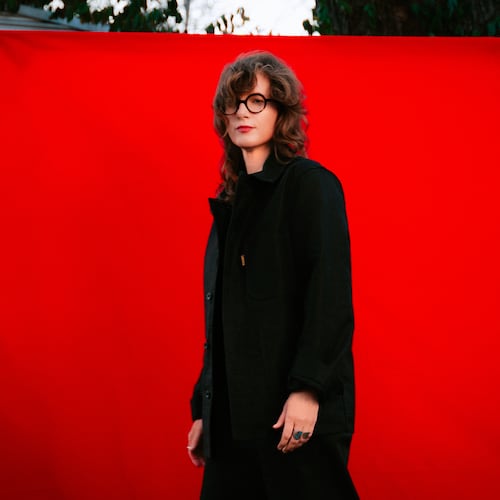On the international entomology market, an Asian walking leaf insect (Phylliidae) might run you $50 to $70 a pop. Fortunately, artist Jennifer Angus usually buys her bugs in bulk and tends to get a better price.
You can see Angus’ critter symphonies, featuring a number of Phyllidae, in her jaw-dropping installation “Lady Bug” through Dec. 5 at Kennesaw State University’s Bernard A. Zuckerman Museum of Art.
In the museum’s Don Russell Clayton Gallery, Angus, a professor in the design studies department at the University of Wisconsin-Madison, has created an astounding insect extravaganza. Using an estimated 3,000 bugs, the artist arranges them in elaborate circle and diamond configurations on the gallery walls like the blond showgirls in Hollywood filmmaker Busby Berkeley’s intricately choreographed dance numbers.
Credit: Photo courtesy of Bernard A. Zuckerman Museum of Art/Horacio Arias
Credit: Photo courtesy of Bernard A. Zuckerman Museum of Art/Horacio Arias
Angus procures her insects through Alain van Vyve, a Belgian bug dealer she has worked with for 30 years. Van Vyve sources grasshoppers in Madagascar and weevils in Papua New Guinea for Angus to use in her art installations, though she admitted that cicadas are her “meat and potatoes.” The largest ones hail from Malaysia and others from Thailand, which has the greatest diversity of cicadas.
The entire exhibition is bespoke: created specifically for the Zuckerman. Installation took a week and a half with Angus’ longtime assistant Emma deVries, various Kennesaw students and staff, and even museum curator Cynthia Nourse Thompson lending a hand by pinning insects to the walls.
“We have not yet had an exhibition of this size that completely transformed the gallery space like this exhibition does,” Thompson said. “Viewers literally walk into the physical artwork.”
The effect is utterly magical.
“Upon entering the gallery, one feels as if transported through a portal into another time and place,” the curator said. “The walls, bathed in a soft hue of pink, the ornamental crystal chandeliers hanging from the ceiling and the patterns across the gallery walls created by hundreds of pinned insects and geometric mirrors allow one to feel as if they are walking into a kaleidoscope.”
Ironically, though the stars of her show are long expired, Angus views her infestation orchestrations as all about conservation. Her goal is to have viewers consider the lowliest creatures among us — cicadas, grasshoppers, rhinoceros beetles and moths. Angus wants viewers to see these often feared, exterminated or simply ignored creatures as vital and beautiful team members in supporting our planetary health, whose lives and habitats have been endangered by climate change and pesticides.
“The noted biologist E.O. Wilson described insects as the little things that make the world work,” said Angus, speaking from her home in Wisconsin. “We obviously need them for pollination and decomposition of matter, but I think the most important role is as a vital link in the food chain.
“Everything really collapses without insects. In 2017 there was a paper published out of Germany. It was a 30-year study, and during that time, 70% of winged insects had disappeared. That is an apocalypse. You know, the warning bells are out there.”
Credit: Photo courtesy of Bernard A. Zuckerman Museum of Art/Mike Jensen
Credit: Photo courtesy of Bernard A. Zuckerman Museum of Art/Mike Jensen
“Lady Bug” also deals with another group of oftentimes overlooked creatures that are also essential to the healthy functioning of the planet: women. At the heart of the show are the stories of three female entomologists whose work was critical in the field’s development: Cynthia Longfield (1896-1991), known as Madame Dragonfly; Alice Balfour (1850-1936), or “the Moth Queen”; and Margaret Collins (1922-1996). The first Black woman to earn her Ph.D in entomology, Collins was known as the Termite Lady for her avid interest in those insects.
In deference to that feminine influence in the bug world, “Lady Bug” strikes a decidedly Victorian note, inspired by that era’s domestic maximalism.
The 19th century was an era of remarkable innovation and industrialization, and a parallel almost obsessive scientific study and devotion to the natural world. It was also an age of “excess and dubious taste,” Angus said.
The artist was inspired by that Victorian love of scientific exploration and by British author Beatrix Potter and her “The Tale of Two Bad Mice,” which turns mice into the lovable heroes of nursery fiction.
“I thought, well, why can’t we do that with insects? If I anthropomorphize them, then we can think of them as leading lives parallel to our own, having jobs, having families — which, in many respects, is true — and so, create this empathy for insects.”
“That’s one of my goals, is to sort of reenvision how we think of insects that, in fact, are incredibly beautiful,” Angus said.
To that end in “Lady Bug,” scores of Angus’ bugs are arranged under bell jars in vignettes that will send anyone susceptible to whimsy into paroxysms of delight. In deliciously meta moments, horned beetles study documents describing esoteric entomological and botanical phenomena from honey bee parasites to common mallow. In adorable moments frozen under glass, these miniature hard-shelled scientists try to divine the secrets of the natural world much like the humans who, in turn, study them.
Credit: Photo by Alanna Foxwell
Credit: Photo by Alanna Foxwell
For her glorification of the insect world, Angus has naturally made some fans. She has spoken at the Entomological Society of America conference, as well as hosted exterminators at her studio.
Angus recycles her bugs in show after show, including some cicadas she’s been working with since 2003. Her bugs are preserved in multiple ways: dried like fruit leather or taxidermied, their guts removed and replaced with cotton batting or other materials.
“We keep the best specimens at eye level” Angus said. Damaged insects that have required a stint in Angus’ “bug hospital” are often hidden up high or down low. If a toddler loses his mind in one of her exhibits and something is definitively smashed, Angus can do like another Victorian-era antihero and Dr. Frankenstein their bodies, hiding the devastation by creating little cicada ladies wearing dresses with wax bodies and grasshopper arms.
“Nothing,” the artist said, “really goes to waste.”
IF YOU GO
“Lady Bug”
Through Dec. 5. 10 a.m.-5 p.m. Tuesdays-Fridays, noon-5 p.m. Saturdays. Free. Bernard A. Zuckerman Museum of Art, 492 Prillaman Way, Kennesaw. 470-578-3223, kennesaw.edu.
Artist Jennifer Angus will speak at the Zuckerman Museum of Art at 5 p.m. Nov. 6. Free but reservations are required. kennesaw.edu.
About the Author
Keep Reading
The Latest
Featured




